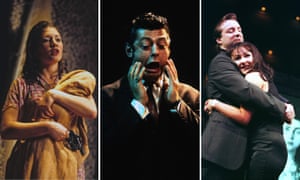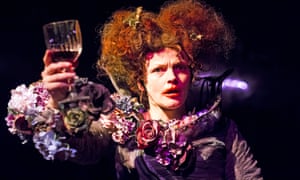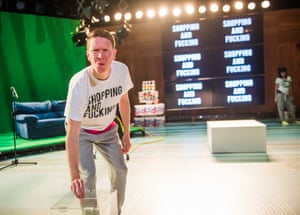

It’s good to see The Skriker in the Rift season because it hints at the fact that the range of plays produced in the 90s goes far beyond the In-Yer-Face moniker, which has tended to define the era. With hindsight that tag hasn’t always been most helpful because of the narrowness of the label and its emphasis on sex and violence. Yes, the 1990s did produce Kane, Ravenhill and Jez Butterworth, but it produced a wide range of voices including Roy Williams, Jonathan Harvey, Judy Upton, Zinnie Harris, David Eldridge, Helen Edmundson, David Harrower, Ayub Khan-Din, Martin McDonagh, Linda McLean, Patrick Marber and David Greig to name just a few. Scotland – in particular the Traverse in Edinburgh – saw as much of a boom as London.
The 1990s also produced Frantic Assembly and Blast Theory and saw companies such as Complicite and Forced Entertainment come to maturity. The Skriker was a boundary-breaking collaboration with choreographer Ian Spink, a coming together of text and movement that is common now in British theatre but wasn’t at the time. Stephen Daldry’s 1992 production of An Inspector Calls, designed so brilliantly by Ian McNeill, was another marker that British theatre was beginning to change as we moved into a new decade.
Back in 1991, in his book One Night Stands, Michael Billington was able to assert with confidence that “new writing for the theatre is in a state of crisis.” Less than five years later it would be equally possible to assert that UK playwriting had not enjoyed such a time of invention and boom since the late Elizabethan and early Jacobean period. We could argue forever whether Blasted really is a great play or whether Shopping and Fucking will still be revived in 50 years’ time, but actually the individual brilliance and longevity (or not) of particular plays is less interesting than the conditions in theatre that existed back in the early-to-mid 1990s that supported such a thrilling explosion of writers.

In the 90s, new writing had an opportunity to thrive. If there is one thing that the 1990s playwriting boom tells us it is that theatrical activity breeds ever more theatrical activity and that leads to more writers and theatre-makers and bigger audiences.
When the Bush’s Dominic Dromgoole and the Court’s Stephen Daldry agreed over a drink one evening to start claiming that it was a golden age for British playwriting, who is to say whether it was fact or myth. What it certainly did was fuel confidence, which in theatre breeds more confidence. One hit leads to another.
The London pub theatre scene which had lost the radical impetus of its invention in the late 1960s, began to thrive again in the 90s. Soho Theatre – then the Cockpit Theatre – expanded its writers’ programme. Touring companies including Out of Joint, founded by Max Stafford Clark after leaving the Court, contributed to the excitement around new writing. Vicky Featherstone, an assistant director at the Court in 1990 and then a literary associate at the Bush, took over Paines Plough in 1997 where new writing once again thrived.
Dromgoole’s presence at the Bush and the arrival of Daldry to reinvigorate the Royal Court were clearly significant factors in the blooming. In the case of Daldry it wasn’t just the fact that, like Dromgoole, he had a sharp eye and keen ear for the possibilities of a play, but also because he realised that the Court needed to expand production at a time of financial constraint, not retract. More slots meant more voices and newer voices.

Bringing Graham Whybrow into the Court as literary manager spurred the march of a new generation who wanted to reflect the world in which they found themselves, using a language and form that often owed more to popular culture, or growing up in a house where the TV was always on and the adverts blaring, than to Look Back in Anger.
Writing in the 2002 edition of his astute book The Full Room, Dromgoole observed that it was way too soon to know which of the plays from the period might survive, but added: “What is beyond denial is that there is no more fertile soil for greatness than an enthusiasm for the task, and there has been no more enthusiastic time than the one just past.” Twenty years on, it may still be too soon to say which of the plays from that period will survive, but British theatre is still reaping the benefits of a remarkable time.
